Baghdad - A Historical and Cultural Hub of Iraq's Rich Legacy
Baghdad, the capital of Iraq, is a prosperous city known for its rich history and vibrant present. It was founded by Abbasid Caliph Abu Jaafar al-Mansur in 135 AH / 762 AD, located west of the Tigris River. The city’s circular design was a notable achievement in Arab architecture and urban planning.
Under Caliph Harun al-Rashid, Baghdad flourished, with extensive construction and competition among Abbasid caliphs and princes to build palaces, mosques, and gardens. This development solidified Baghdad’s status as the capital of the Islamic world for many centuries.
Baghdad has ancient roots, dating back to the Babylonian civilization. Historians trace its existence to the time of kings like Hammurabi and Nebuchadnezzar, with the city originally named Baghdado or Baghdada, meaning “garden of the lover” in the Akkadian and Aramaic languages. Persian interpretations suggest that “Bagh” means garden and “Dad” means gift, giving the name the meaning “the gift garden.”
Here is a brief overview of some of its famous landmarks:
Baghdad's Vibrant Markets - A Journey Through Al-Rasheed Street and Surrounding Areas"
Al-Safafeer Market - A Center of Traditional Copperwork in Baghdad
Al-Safafeer Market, also known as Al-Nahhasin, is a well-known market in Baghdad, famous for its long-standing tradition of copperwork. The craft of copper manufacturing has been deeply embedded in the city’s culture for centuries and continues to thrive in its traditional, folk style. Skilled artisans still use age-old techniques to craft copper items, and the market serves as a vibrant hub for this craft.
In Al-Safafeer Market, visitors can find a wide variety of copper products, including household tools, decorative pieces, and an assortment of souvenir goods. These items are meticulously crafted, often adorned with intricate and precise engravings that highlight the expertise and artistry of the craftsmen. The market offers not only practical items but also beautiful, ornamental objects, making it a popular destination for those seeking unique, handcrafted copper goods.
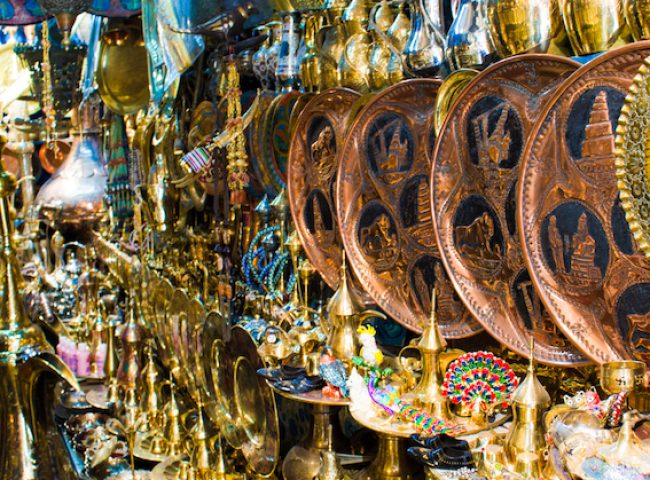
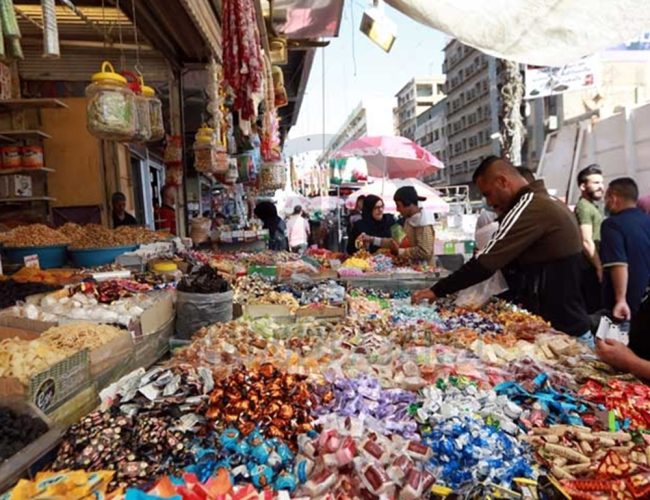
Shorja Market - A Landmark of Baghdad's Copperwork and Tradition
Shorja Market is one of the most iconic and bustling markets in Baghdad, renowned for its vibrant atmosphere and rich cultural history. The market is particularly famous for the traditional craft of copperwork, a craft that has been passed down through generations and is still widely practiced in its authentic folk style. This timeless skill is deeply ingrained in the city’s heritage, with local artisans continuing to create copper goods using methods that have remained largely unchanged for centuries.
Within Shorja Market, visitors will find an extensive variety of copper items, ranging from household tools and kitchenware to decorative pieces and souvenir goods. The products are carefully handcrafted, each featuring intricate and precise engravings that showcase the remarkable craftsmanship of the artisans. These beautifully crafted copper goods not only serve practical purposes but also stand as works of art, each piece telling a story of Baghdad’s rich artistic tradition.
Al-Bazazeen Market - A Tradition of Coppercraft in Baghdad
Al-Bazazeen Market is a well-known and vibrant market in Baghdad, deeply rooted in the city’s cultural history. It is especially famous for its rich tradition of copper craftsmanship, a skill that has been passed down through generations and continues to be practiced in its traditional, folk style. The art of copper manufacturing remains a cornerstone of the market, with skilled artisans continuing to produce high-quality copper goods using methods that have been cherished and preserved for centuries.
In Al-Bazazeen Market, visitors will find a wide array of products made from copper, including household tools, kitchenware, decorative items, and unique souvenir goods. These copper items are not only functional but are also beautifully crafted with intricate and precise engravings that showcase the remarkable skill and attention to detail of the artisans. Whether it’s a beautifully decorated piece for your home or a practical item for daily use, the market offers a variety of copper goods that reflect the rich cultural heritage of Baghdad.
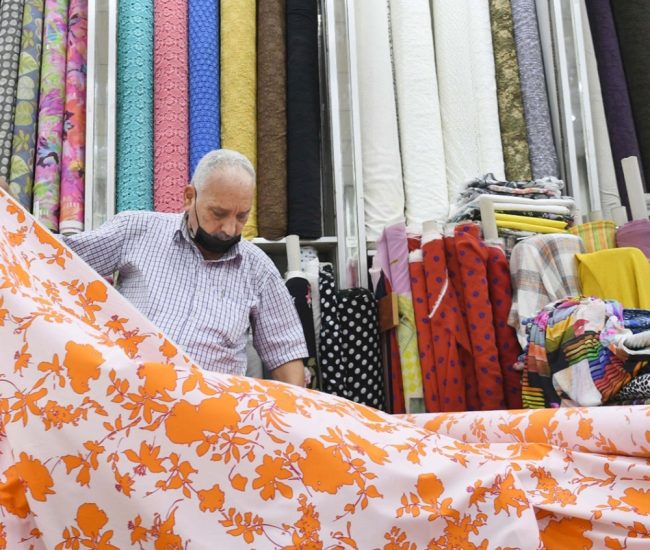
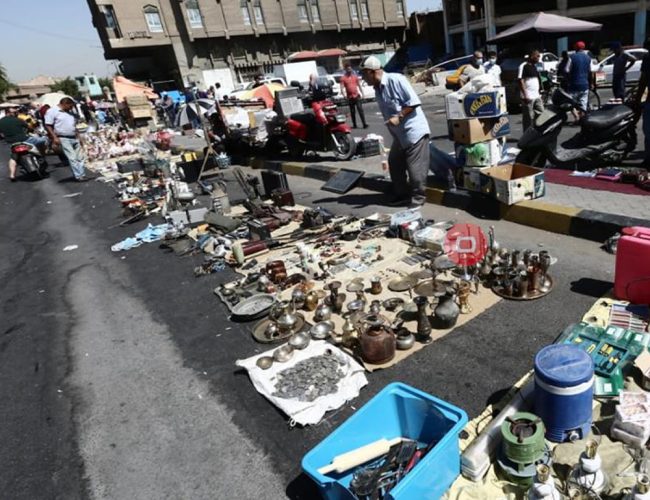
Haraj Market - A Treasure Trove of Antiques and Historical Finds in Baghdad
Haraj Market is a renowned and distinctive market located in the heart of Baghdad, famous for its unique offering of used materials and items with historical and archaeological significance. Unlike other markets, Haraj Market is a treasure trove where visitors can find rare, antique, and often strange items that hold both cultural and historical value. It is a place where the old meets the new, offering everything from vintage furniture to ancient artifacts that are difficult to find elsewhere in the city.
One of the main attractions of Haraj Market is the wide range of high-end antiques and collectibles available at remarkably low prices, making it a popular destination for bargain hunters and those seeking unusual pieces. The market draws people from all over Baghdad and beyond, both for the variety of goods on offer and the affordability of the items.
Al-Ghazal Market - A Haven for Rare Antiques and Historical Treasures
Al-Ghazal Market is a well-known and distinctive market located in the heart of Baghdad, celebrated for its unique collection of used materials and very old items that hold historical and archaeological value. This market is unlike any other, offering a wide range of rare and unusual items that cannot typically be found in other markets throughout the city. From vintage collectibles to ancient artifacts, Al-Ghazal Market is a true treasure trove for those in search of something truly unique and remarkable.
The market is especially popular for its high-end antiques and priceless artifacts, many of which are sold at surprisingly affordable prices, making it a favored destination for bargain hunters and collectors alike. Visitors can explore a variety of goods, from historical relics to exquisite pieces of art, each with its own story to tell. This combination of rarity and affordability adds to the market’s appeal, attracting people from across Baghdad and beyond.
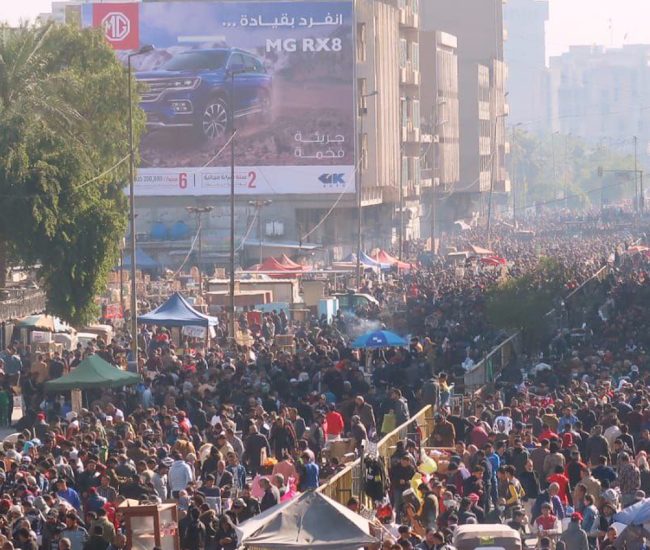
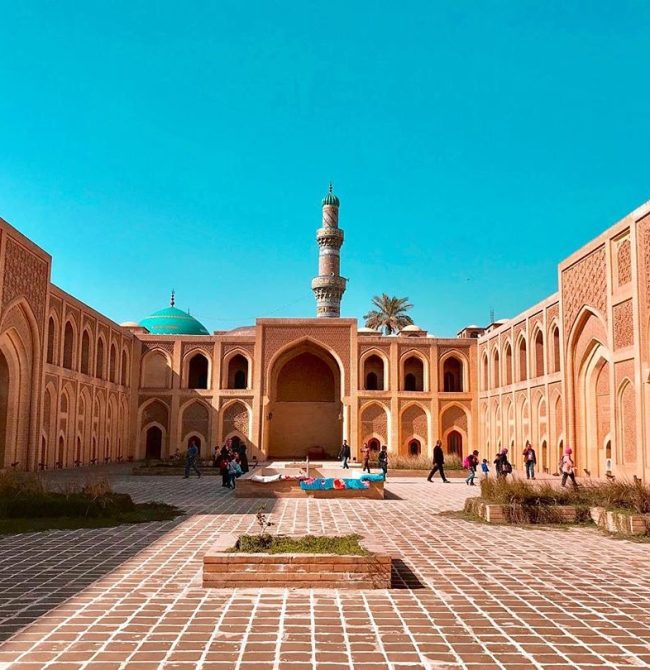
Al-Mustansiriya School - A Center of Knowledge and Innovation in the Abbasid Era
Al-Mustansiriya School was one of the most important universities in the Islamic world during the Abbasid era, renowned for its focus on subjects like Arabic, religious sciences, astronomy, mathematics, medicine, and pharmacy. It also included a private hospital for student training.
Located on the side of Rusafa near Al-Shuhada Bridge, overlooking the Tigris River, the school was built during the reign of Caliph Al-Mustansir Billah (623-640 AH) and named after him. Construction took six years, with the Abbasids allocating about three-quarters of a million gold dinars for its building and endowments worth around one million gold dinars, generating an annual income of seventy thousand gold dinars.
The school was designed in a rectangular layout (104.8 m by 44.2 m), with a central courtyard of 1,710 square meters. The building featured large vaults, open halls, and beautiful decorations. It housed student rooms on two floors, study areas, a library with about 80,000 books, a pharmacy, hospital, orchard, a hadith house, and another dedicated to the Holy Qur’an.
The Abbasid Palace - A Testament to Baghdad's Architectural Grandeur
The Abbasid Palace is one of the most significant historical buildings in Baghdad from the second Abbasid era, located near Bab al-Moadham on the river side. Scholars attribute its construction to Caliph Al-Nasir Li-Din Allah, who ruled from 575 AH to 623 AH. During his reign, several important landmarks were built in Baghdad, including this palace. The palace’s architectural design features a central courtyard, with two floors of rooms decorated with intricate knots and muqarnas made of bricks, showcasing the craftsmanship of the time.
One of the notable features of the palace is an iwan, which is a large vaulted space with a facade and ceiling decorated with brick motifs. During the palace’s maintenance, another iwan was constructed on the river side to enhance the structure. Due to the palace’s numerous facilities and its architectural similarities to the design of Al-Mustansiriya School, some historians have speculated that it could be the Sharabi School mentioned in historical records, adding to its historical intrigue. The Abbasid Palace stands as a testament to the grandeur of the Abbasid era and remains an important piece of Baghdad’s rich heritage.
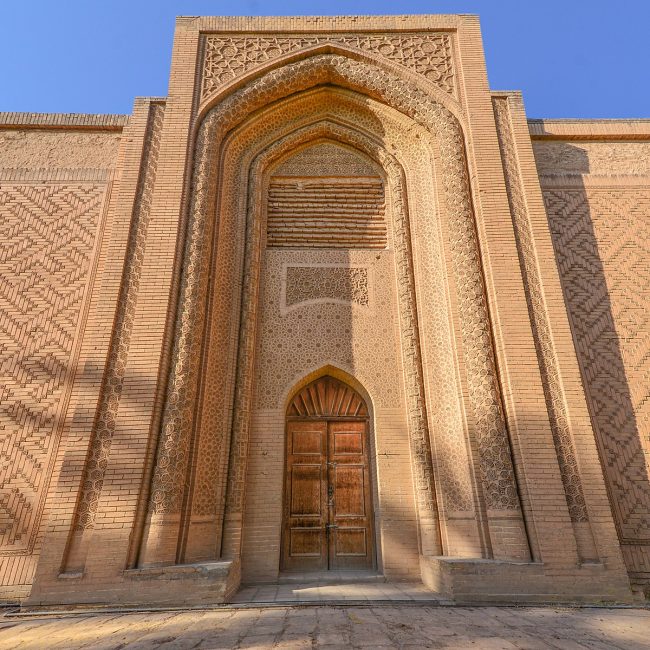
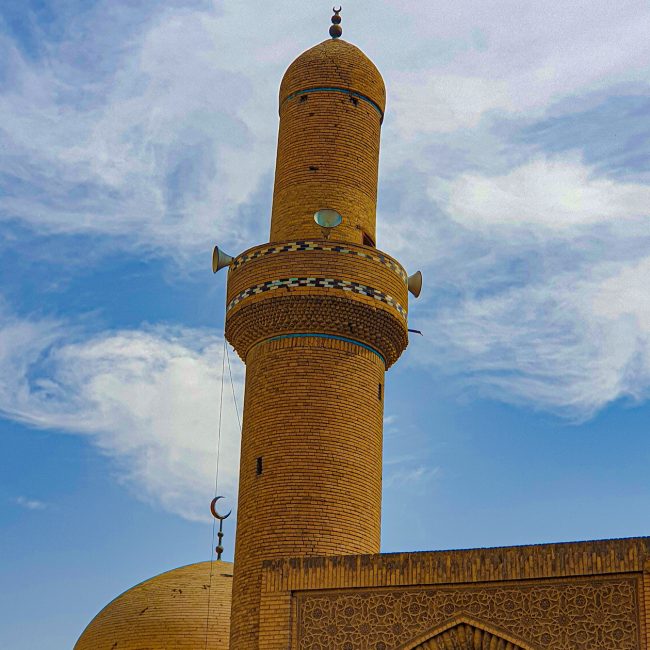
Al-Murjaniya School - The Legacy of Baghdad’s Murjan Mosque
Al-Murjaniya School, now commonly referred to as the Murjan Mosque, is a historically significant site located in the Al-Shorja area on Al-Rasheed Street in Baghdad. The school was originally established by Amin al-Din Murjan in 758 AH / 1357 AD, roughly a century after the Abbasid era came to an end. During its early years, Al-Murjaniya School was designed in a way similar to the famed Al-Mustansiriya School, featuring dedicated rooms for study as well as spaces to accommodate students, thus providing a comprehensive environment for learning.
In its prime, Al-Murjaniya School was an important educational institution in Baghdad, contributing to the intellectual and cultural development of the region. However, in the early 20th century, the school was demolished, and a mosque was constructed in its place, which is what stands there today as the Murjan Mosque. Despite the transformation of the building, some remnants of the original school still survive, offering a glimpse into its historical past. The Murjan Mosque, while now serving as a place of worship, continues to bear the legacy of the Al-Murjaniya School and stands as a testament to Baghdad’s rich history of education and architectural evolution.
Aqar Quf - The Ancient Kassite Capital and its Iconic Ziggurat
10 miles to the west of the city of Baghdad, today stands the ruins of Aqar quf (Dur Kurigalzu), the capital of Iraq during the Kassite era (1595-2171 BC). The Kassites had settled in the city of Babylon before the formation of their political entity and they quoted many of the origins of the Babylonian civilization and after the fall of the Babylon first dynasty, and in a short period of time, they were able to expel the Hittites and establish their state. At first they made the city of Babylon as their capital, and in the middle of their reign, they moved to a luxurious city known as Kurigalzu.
Among its most prominent landmarks today is its towering ziggurat, which is one of the largest listed towers remaining today in Iraq. Its current height is about 57 m and it has a square base (67 x 69 m). However, it is believed that the original height was about 70 meters, and it rises to it by three stairs. In addition to this listed edifice, a group of temples was discovered near the ziggurat, while the remains of the city’s palaces were discovered at a distance of about one kilometer to the southwest of the ziggurat.
Settlement continued in the city after its founding during the Neo-Babylonian era, and even through some Islamic eras.
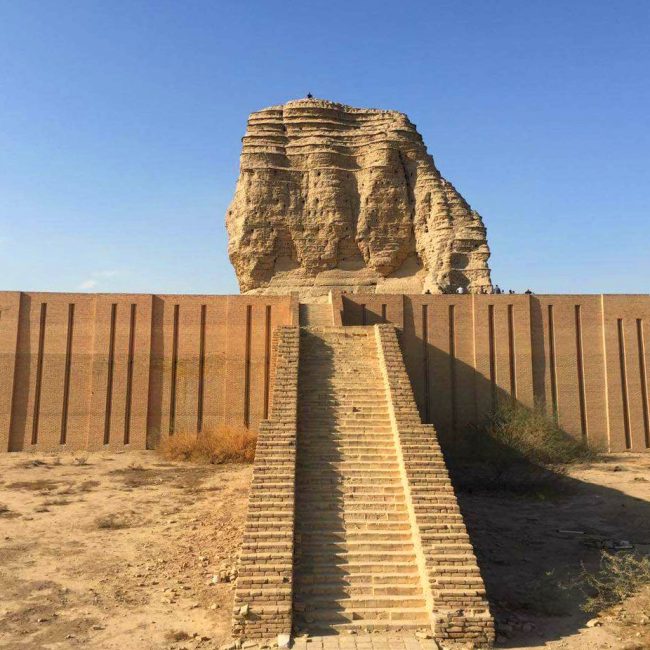
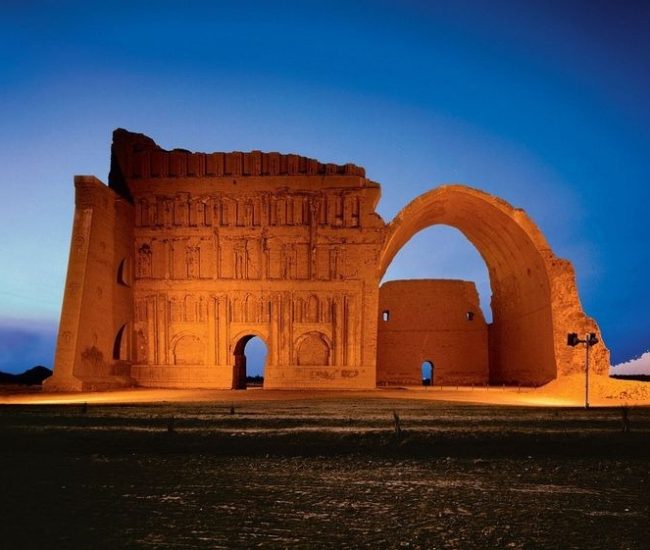
Al-Mada'in (Ctesiphon) - History and the Taq Khosrau Arch
Al-Mada’in, also known as Ctesiphon, is a collection of seven ancient cities, located 30 km southeast of Baghdad. The name “Al-Mada’in” is the Arabic translation of “Ctesiphon.” The seven cities include Al-Atiqa, Isfapur, Wah Ardasher, Hanbosafor, Darz Nidan, Wahe Jundikhusra, and Sabat.
One of the most notable landmarks of Al-Mada’in is the Taq Khosrau, part of the White Palace, which houses the Throne Hall of Khosrau I. The Taq Khosrau was built after Khosrau I’s military campaign against the Byzantines in 540 AD, and it is decorated with depictions of the Battle of Antioch between the Persians and the Romans. The Taq Khosrau is considered one of the largest and most impressive arches ever built, standing 32 meters high, with a span of 25.5 meters between its walls and a depth of 48 meters. The thickness of its walls is 7 meters.
In 1888, a third of the structure was destroyed by a flood. Reconstruction efforts began in the 1980s but were halted in 1991 during the Gulf War before completion.
Al-Qashla - Ottoman Heritage and Historical Landmark of Baghdad
Al-Qashla is a Turkish word derived from “Qashlan,” meaning “Mashta,” and was used to refer to soldiers’ barracks during times when they were encamped and not at war in the winter. Located on the Rusafa side of Baghdad, opposite Al-Saray Mosque, it occupies a rectangular area along the eastern bank of the Tigris River.
Construction of Al-Qashla began in 1861 AD under Ottoman Governor Namik Pasha, but was not completed during his reign. Governor Medhat Pasha finished the building in 1869 AD, adding a second floor and additional rooms. Built using remnants of the Abbasid wall of Baghdad, Al-Qashla features a clock tower in its inner courtyard, which was used to wake soldiers. The tower, standing 23 meters high, has a clock with four faces, gifted by British King George V. This clock was a notable event in Baghdad, occurring ten years after the famous Big Ben clock in London.
Al-Qashla witnessed significant historical events, including the raising of the British flag in 1917 AD after their victory over the Ottoman army, and the crowning of King Faisal I in 1921 AD. Today, the building houses the Ministries of Finance and Justice. Due to its architectural and historical significance, the Department of Antiquities has undertaken preservation efforts, with plans to use the building as a museum to display valuable heritage artifacts.
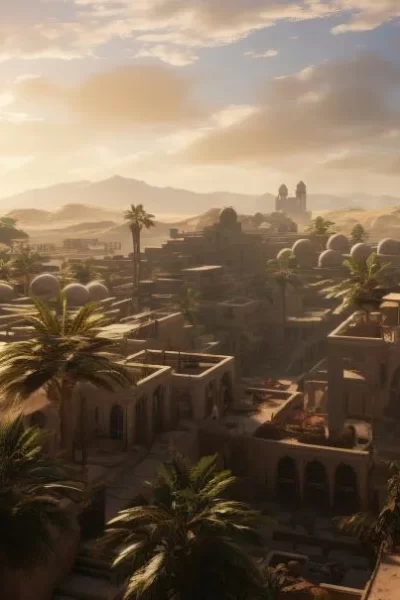
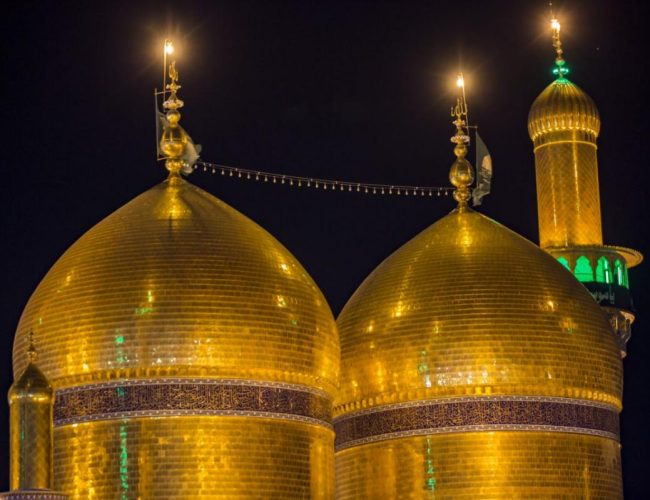
Mashhad Al-Kadhimi - A Historic Shrine and Pilgrimage Site in Baghdad
Mashhad Al-Kadhimi is one of the most renowned shrines in Baghdad, historically situated at the site of the graves of Quraysh, a designation used during the Abbasid period. It is the resting place of two revered Imams: Imam Musa al-Kadhim, who was buried here in 802 AD, and Imam Muhammad al-Jawad. To honor these great figures, a large mosque was constructed around their shrines, which today is crowned by two magnificent domes and four golden minarets.
The construction of the mosque began in 1515 AD, and over the centuries, it has become a significant religious and cultural site. The mosque not only serves as a place of worship but also as a symbol of the city’s deep historical and spiritual heritage. The shrine continues to attract visitors from all over the world, making it one of the most important pilgrimage sites in Baghdad.
Al-Imam Al-Adham Mosqu - Mausoleum of Imam Abu Hanifa
The Al-Imam Al-Adham Mosque is located in the Adhamiya area of Baghdad and houses the mausoleum of Imam Abu Hanifa al-Nu’man bin Thabit al-Kufi, the founder of the Hanafi school of Fiqh. Imam Abu Hanifa, one of the most influential Islamic scholars, was buried in the al-Khayzaran tombs in 105 AH / 767 AD. In the years that followed, a city grew around the mausoleum, which came to be known as Adhamiya.
To honor Imam Abu Hanifa, a large dome was constructed over his mausoleum, known as Mashhad Abu Hanifa. In addition to the dome, a school for the followers of the Hanafi school of thought was built adjacent to the site. Over time, however, this building underwent multiple renovations and changes. Its structure was repeatedly altered, particularly during the Ottoman period, when the sultans and governors of the empire undertook significant efforts to renew its architecture.
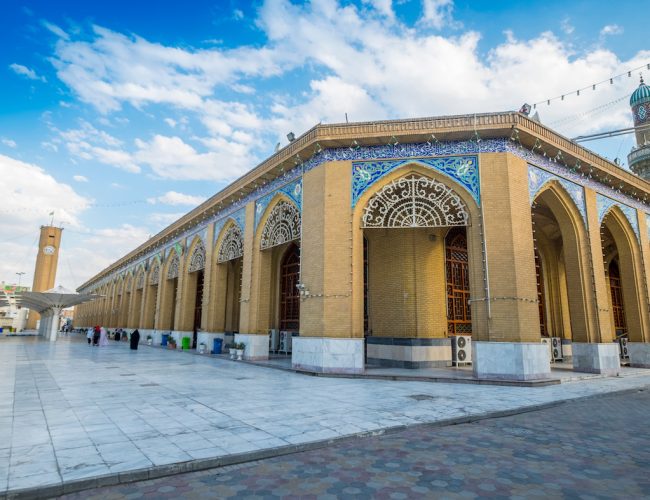

Sheikh Omar Al-Suhrawardi Shrine - A Spiritual Landmark in Baghdad
The Sheikh Omar Al-Suhrawardi Shrine is located in the Sheikh Omar area, near Bab Al-Wastani in Baghdad. This shrine is dedicated to the renowned Sufi scholar and ascetic, Sheikh Shihab Al-Din Omar Al-Suhrawardi, who passed away in 1225 AD. The shrine itself is housed under a distinctive conical dome, which bears a resemblance to the dome of Zumurud Khatun, further enhancing its architectural charm.
The mosque surrounding the shrine is considered one of the oldest in the city of Baghdad, making it an important historical and religious site. Over the centuries, the shrine has become a place of pilgrimage for those seeking to pay their respects to the memory of Sheikh Omar Al-Suhrawardi, whose teachings and spiritual insights have left a lasting impact on Sufism. The site remains a significant part of Baghdad’s rich cultural and spiritual heritage, attracting visitors who come to explore both its historical significance and architectural beauty.
Sheikh Maarouf Al-Karkhi Mosque - Legacy of a Sufi Scholar in Baghdad
The Sheikh Maarouf Al-Karkhi Mosque is dedicated to Abu Mahfuz Maarouf bin Fayrouz al-Karkhi, one of the prominent scholars of his time, living during the second century AH. He was widely recognized as a leading Sufi figure in Baghdad, known for his deep piety, taqwa (God-consciousness), and dedication to Sufism. Sheikh Maarouf Al-Karkhi is celebrated for his spiritual teachings and his significant contribution to the development of Sufism in the region.
He passed away in Baghdad in 200 AH / 815 AD and was buried in the historic Al-Shwaniziyah cemetery, also known as the ancient cemetery of Bab Al-Dair, located on the Karkh side of the city. His shrine is an architectural masterpiece, renowned for its exquisite design and magnificent beauty. The structure stands as a testament to the lasting impact of Sheikh Maarouf Al-Karkhi’s legacy, not only as a spiritual guide but also as an important historical and cultural figure in Baghdad. The mosque and shrine continue to attract visitors, serving as both a place of worship and a symbol of the rich heritage of Islamic mysticism in the city.
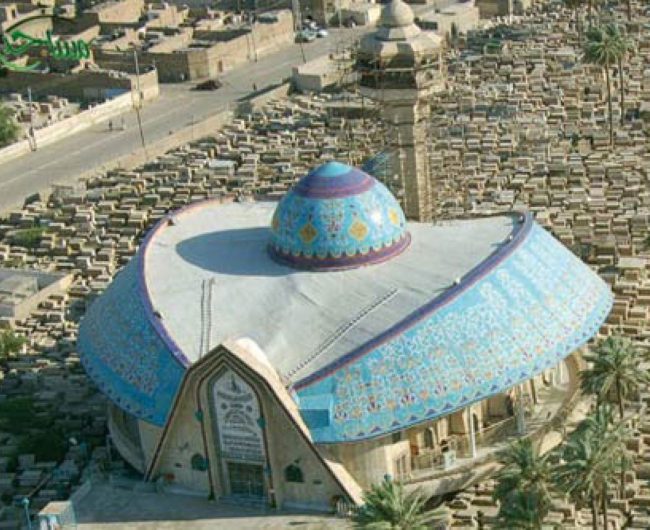
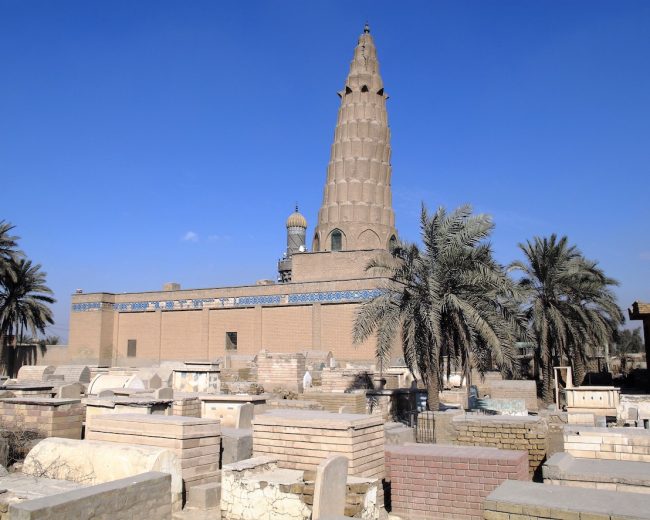
Zumurud Khatun Tomb - An Abbasid Architectural Landmark
The Zumurud Khatun Tomb is located on the western side of Baghdad, in the area of Sheikh Maarouf. It is crowned by a striking, towering dome that rests on eight sides, making it a notable architectural landmark. Zumurud Khatun, the wife of Caliph Al-Mustadha Bi Amr Allah, commissioned the construction of the tomb during the reign of Caliph Al-Nasir Li-Din Allah. The tomb was completed in 599 AH / 1202 AD and was intended as her final resting place.
Despite its historical significance and distinct design, this tomb is often mistakenly referred to by the local populace as the tomb of Sitt Zubaydah, the wife of the famous Abbasid Caliph Harun al-Rashid. In reality, Zumurud Khatun’s tomb is a testament to her influence and the architectural elegance of the time. The tomb stands as an important historical and cultural site, symbolizing the legacy of the women who played significant roles in the Abbasid period.
The Caliphs Mosque - An Abbasid-Era Icon of Baghdad’s Heritage
The Caliphs Mosque is one of the oldest and most historically significant mosques in Baghdad, located on Al-Jumhuriya Street in the district of Souk Al-Ghazl, on the Al-Rusafa side of the city. Its construction dates back to the Abbasid era, specifically during the reign of the Caliph between 289 AH and 295 AH. The mosque was originally built to serve as the designated Friday prayer mosque, situated to the east of the Hasani Palace.
Over time, the mosque has been known by several names, including Al-Qasr Mosque, Al-Khalifa Mosque, and the Ghazal Market Mosque. Each of these names reflects the mosque’s significance in different historical contexts and locations within Baghdad. One of the most notable features of the mosque is its historical minaret, which is regarded as an exceptional example of architectural craftsmanship. The minaret’s unique design and towering presence make it a key architectural landmark in the city, further emphasizing the mosque’s historical importance. The Caliphs Mosque remains a symbol of the rich cultural and religious heritage of Baghdad, continuing to stand as a testament to the city’s legacy from the Abbasid period.
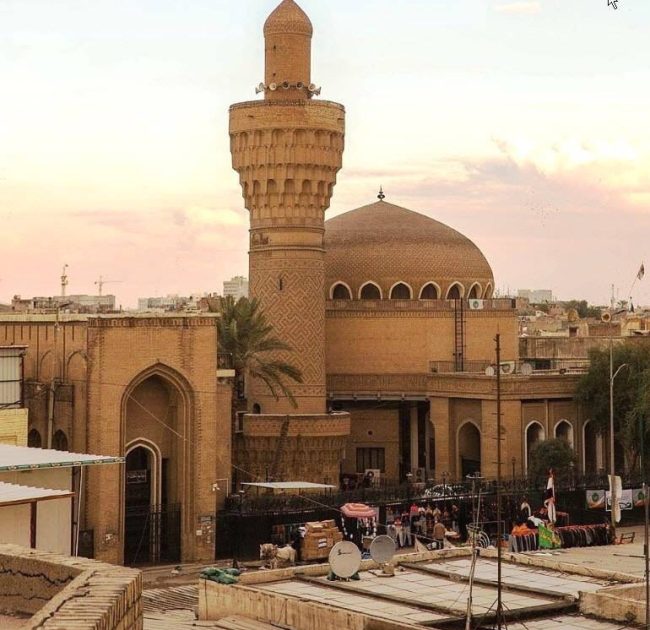
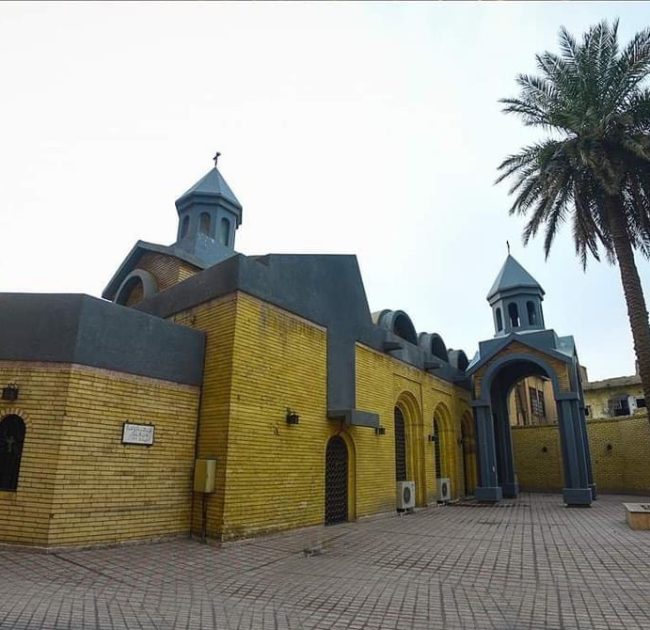
Virgin Mary Church - A Historic Symbol of Christian Heritage in Baghdad
The Virgin Mary Church is located in Al-Midan Square, in the Bab Al-Moadham area of Baghdad. This church is considered one of the oldest and most historically significant churches still standing in the city, with its construction dating back to 1640 AD. The church was originally built by the Armenian community on a plot of land that was granted to them by the Ottoman Sultan Murad IV. Over time, the ownership of the church changed hands. After the Armenians, the property passed to the Nestorians, and later, it was taken over by the Orthodox Armenians, who continue to maintain it to this day.
Throughout its long history, the Virgin Mary Church has been a central place of worship and a symbol of the rich Christian heritage in Baghdad. Its enduring presence in the heart of the city highlights the historical diversity and cultural exchange that has characterized Baghdad over the centuries. The church continues to serve as a significant religious site for the Orthodox Armenian community, preserving its heritage while also contributing to the broader tapestry of the city’s religious and cultural landscape.
The Iraqi Museum - Preserving the Legacy of Ancient Civilizations
This museum is located on the Karkh side at the square named after its name. The Iraqi Museum includes the relics of the peoples that inhabited Mesopotamia from time immemorial in antiquity until the Arab and Islamic eras, i.e. the oldest civilizations in prehistoric times, then the civilizations of the Sumerians, Akkadians, Babylonians, Assyrians, Chaldeans, Seleucids, Hadrians, the period of the Arabs of the Hera and the Islamic Arabic ages. The antiquities were organized in the museum halls according to the chronology of these civilizations.
The museum has a library full of topics of ancient history and civilizations in particular, in addition to various ancient arts and in various languages. This museum is considered one of the most important antiquities museums in the world in terms of its inclusion of various cultural roles.
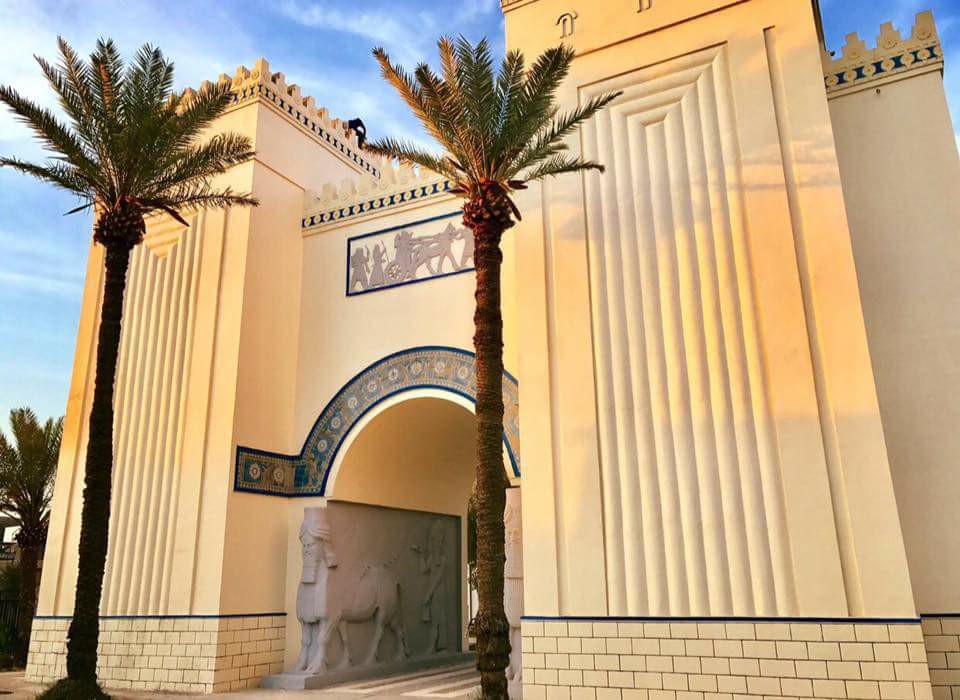
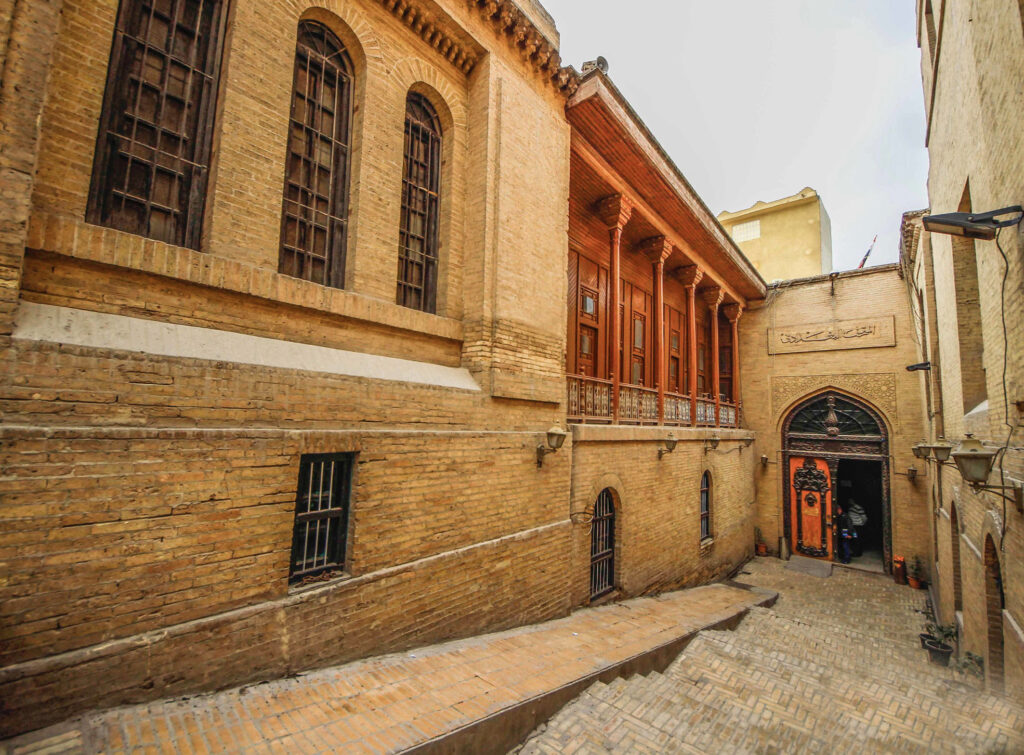
The Baghdadi Museum - A Cultural Archive of Baghdad's Heritage and Traditions
The Baghdadi Museum is situated on Al-Mamoun Street, near Al-Shuhada Bridge, and serves as an important cultural and historical institution in Baghdad. The museum features life-size statues that represent various traditional Baghdadi crafts, as well as scenes depicting aspects of the original Baghdadi heritage. Many of these scenes are rapidly disappearing due to industrialization and social changes, making the museum a vital repository for preserving the city’s cultural identity.
The museum is managed by the Municipality of Baghdad, which ensures the preservation and continued operation of this important institution. By combining historical artifacts, literature, and cultural exhibits, the Baghdadi Museum plays a crucial role in educating visitors about the rich heritage of Baghdad and its ongoing legacy.
Al-Saadoun Statue - An Iconic Landmark in Baghdad's Urban Landscape
The Al-Saadoun Statue, an iconic landmark in Baghdad, was erected in 1933 on the bustling Al-Saadoun Street, a major thoroughfare in the heart of the city. The statue was crafted by the celebrated Italian sculptor Canonica, whose works are recognized for their grand scale and attention to detail. Canonica was known for creating monumental sculptures, and the Al-Saadoun Statue stands as a testament to his exceptional skill and artistic vision.
The statue was erected as a tribute to an important historical figure or event, though the exact symbolism may vary depending on interpretations. It has become an enduring symbol of Baghdad’s rich cultural history and a significant part of the city’s urban landscape. Its location on Al-Saadoun Street, one of Baghdad’s most prominent streets, ensures that it remains a well-known and admired feature of the city. Al-Saadoun Street is a central hub, with its wide traffic and bustling activity, making the statue visible to countless passersby each day.
Over the years, the Al-Saadoun Statue has not only become an important cultural and historical symbol for the city, but it has also gained recognition as a focal point of Baghdad’s identity. As a work of art and a reminder of the city’s past, the statue continues to attract attention from both locals and visitors, serving as a key landmark that celebrates Baghdad’s rich heritage while standing proudly in the modern urban environment.
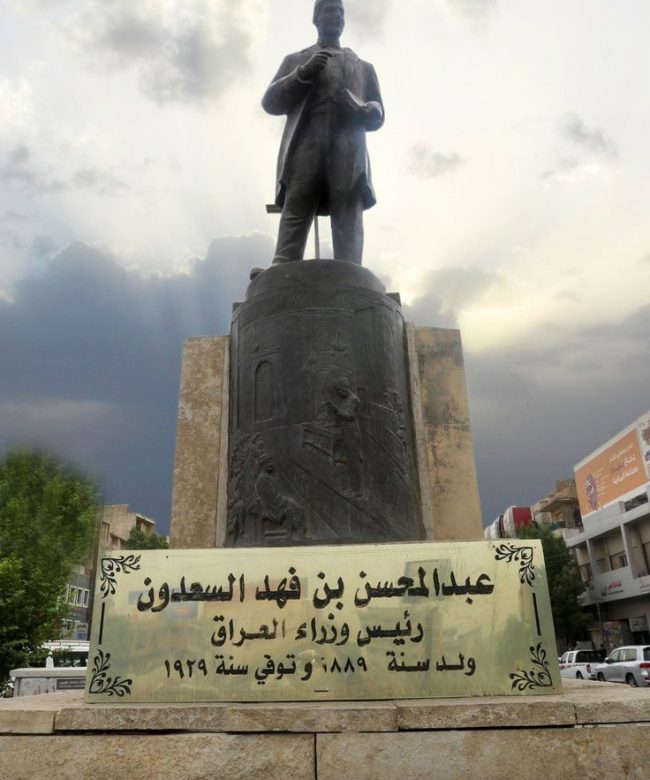

King Faisal Statue - A Monument to Iraq's Modern Founding Father
The King Faisal I Statue, located in the Salhiya area of Baghdad, was erected in 1933 as a tribute to one of the most significant figures in modern Iraqi history. This remarkable statue was created by the renowned Italian sculptor Canonica, who is celebrated for his monumental works and his ability to capture historical figures with great artistry.
King Faisal I, who played a crucial role in the establishment of modern Iraq, is commemorated through this statue, which serves as a reminder of his leadership and the pivotal role he played in shaping the nation’s identity during the early 20th century. The statue stands as a symbol of his legacy and contributions to Iraq’s independence and development.
Frequently Asked Questions - Essential Travel Information for Baghdad
The best time to visit Baghdad is during the cooler months, from October to April, when the weather is more pleasant for outdoor activities. Major religious events like Ashura also attract many visitors. World Gate can assist in planning your trip during the most favorable seasons.
Baghdad is accessible by air, with international flights landing at Baghdad International Airport. From there, you can take taxis or pre-arranged transport to your destination. World Gate can help you with flight bookings and airport transfers.
Yes, travelers from most countries will require a visa to enter Iraq. World Gate can provide assistance with visa applications and guide you through the process for a smooth entry into Baghdad.
While safety can vary, it is important to stay informed about the current situation. World Gate can provide you with the latest safety information and offer guidance on how to stay secure while traveling in Baghdad.
Key attractions include the Al-Shaheed Monument, the National Museum of Iraq, the Zawra Park, and the tomb of Imam Kadhim. World Gate offers guided tours to help you explore the rich cultural and historical sites of the city.
The local currency in Baghdad is the Iraqi Dinar (IQD). While credit cards are not widely accepted in all places, cash is commonly used. World Gate can advise on currency exchange and provide tips on where to exchange money.
It is important to dress modestly and respect local customs. Women should wear a headscarf when visiting religious sites. World Gate can help you understand the cultural norms and ensure you are respectful during your visit.
Baghdad offers a range of accommodations, from luxury hotels to more affordable options. World Gate can help you find the best accommodation based on your preferences and budget, ensuring a comfortable stay in the city.
Alcohol consumption is generally not allowed in public places in Baghdad, and it is important to respect local laws and customs. World Gate can provide you with more information on local regulations and where to find restaurants that cater to international tastes.
World Gate can arrange local transportation for you, including taxis, private cars, and guided tours, to ensure that you can travel around the city easily and safely.
